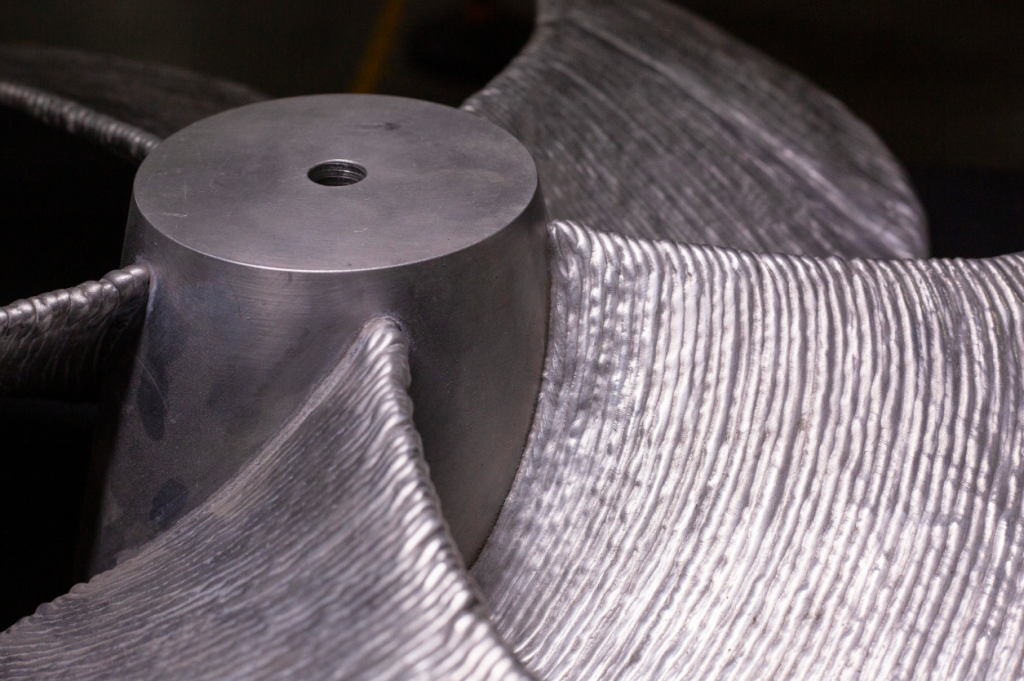The Innovative Manufacturing Cooperative Research Center (IMCRC) and Australian large-format 3D printer manufacturer AML3D have completed their R&D project by commercializing a novel high-strength aluminum wire feedstock for welding and 3D printing applications.
AML3D will continue to work on developing a commercialization strategy, along with testing to industry standards. The wire, which was developed in partnership with Deakin University‘s Institute for Frontier Materials (IFM), is set to “reshape the way” intricate metal objects are manufactured.
“Our patented Wire Additive Manufacturing (WAAM) 3D metal printing process can produce medium to large objects. However, the aluminum alloys we currently use require up to 24 hours of heat treatment to reach optimum strength, which can be costly and creates some logistical challenges,” said Andy Sales, ALM3D’s Executive Director and Chief Technical Officer.

The company representatives share their thoughts on the project
Through this collaboration with IMCRC and IFM, AML3D has created a cost-effective, high-strength aluminum alloy wire that needs only 30 minutes of thermal processing after being printed, according to Sales. This wire, when combined with WAAM technology, has the potential to develop extra applications in fields such as shipbuilding and aviation, further disrupting conventional manufacturing processes.
“By supporting the project and facilitating the introduction to IFM, IMCRC has helped change the trajectory of our business, expanding our potential customer base and creating further opportunities to innovate through R&D,” added Sales.
Thomas Dorin, the Senior Research Fellow at IFM, said, “We were pleased to work with AML3D and IMCRC on this ambitious project, which encompassed over 20 different compositions and iterations. Our chosen alloy, a mixture of aluminum, magnesium, and scandium, has recently been patented, and we’ve also commenced commercial production.”
The next stage of the project will entail printing products to illustrate the wire’s possible applications. The IFM will then collaborate with AML3D to demonstrate to shipbuilders how to print directly at the shipyard, which is an effective way to cut material waste and simplify logistics.
“We’re pleased the project outcomes have solved a real-world challenge for AML3D and the 3D printing industry more broadly,” said David Chuter, IMCRC’s CEO and Managing Director.
Chuter explained that AML3D has the potential to catalyze a step-change for industry and promote the use of more advanced manufacturing methods by providing an alternative to conventional methods such as subtractive manufacturing. Making metal part manufacturing more efficient, cost-effective, and time-efficient is crucial to assisting Australia’s manufacturing industry in becoming more competitive and appealing, which will motivate customers to move production onshore, says IMCRC’s CEO.
Commencing in 2021, the project was born from AML3D’s need for a high-strength aluminum welding wire to use in 3D printing that required minimal or no heat treatment post-manufacture.

WAAM for complex manufacturing metal objects
Following its US market entry strategy, AML3D recently disclosed the sale of a large-scale, industrial ARCEMY ‘X-Edition 6700’ Wire Arc Additive Manufacturing (WAAM) metal 3D printing system to support the US Navy‘s advancing integration of WAAM technology. WAAM, according to the company, is critical for rapidly boosting parts supply to the US Navy’s submarine industrial base. The ARCEMY order was placed by BlueForge Alliance, a US Department of Defense intermediary, with the goal of assisting in the acceleration of advanced manufacturing methods throughout the US defense industrial base.
Previously, Cranfield University spin-out WAAM3D sold a RoboWAAM Advanced to Aichi Sangyo, a Japanese industrial metal processing solutions provider. This is WAAM3D’s sixteenth deposition system sold since 2020, with implementations in eight countries worldwide. WAAM3D debuted a novel large-format metal 3D printer building on the firm’s WAAM technology in 2022. The RoboWAAM metal printer has a large build volume of 2 x 2 x 2m and is equipped with new sensing hardware to assist customers in aerospace, defense, energy, and other industries. The RoboWAAM, which includes its own robotic arm, is designed to be a turnkey metal 3D printing system that can process “virtually any material” available in wire form. It can be used to both make new parts and repair existing metal parts.
What does the future of 3D printing for the next ten years hold?
What engineering challenges will need to be tackled in the additive manufacturing sector in the coming decade?
To stay up to date with the latest 3D printing news, don’t forget to subscribe to the 3D Printing Industry newsletter or follow us on Twitter, or like our page on Facebook.
While you’re here, why not subscribe to our Youtube channel? Featuring discussion, debriefs, video shorts, and webinar replays.
Are you looking for a job in the additive manufacturing industry? Visit 3D Printing Jobs for a selection of roles in the industry.
Feature shows 3D manufactured metal object. Image via AML3D.



